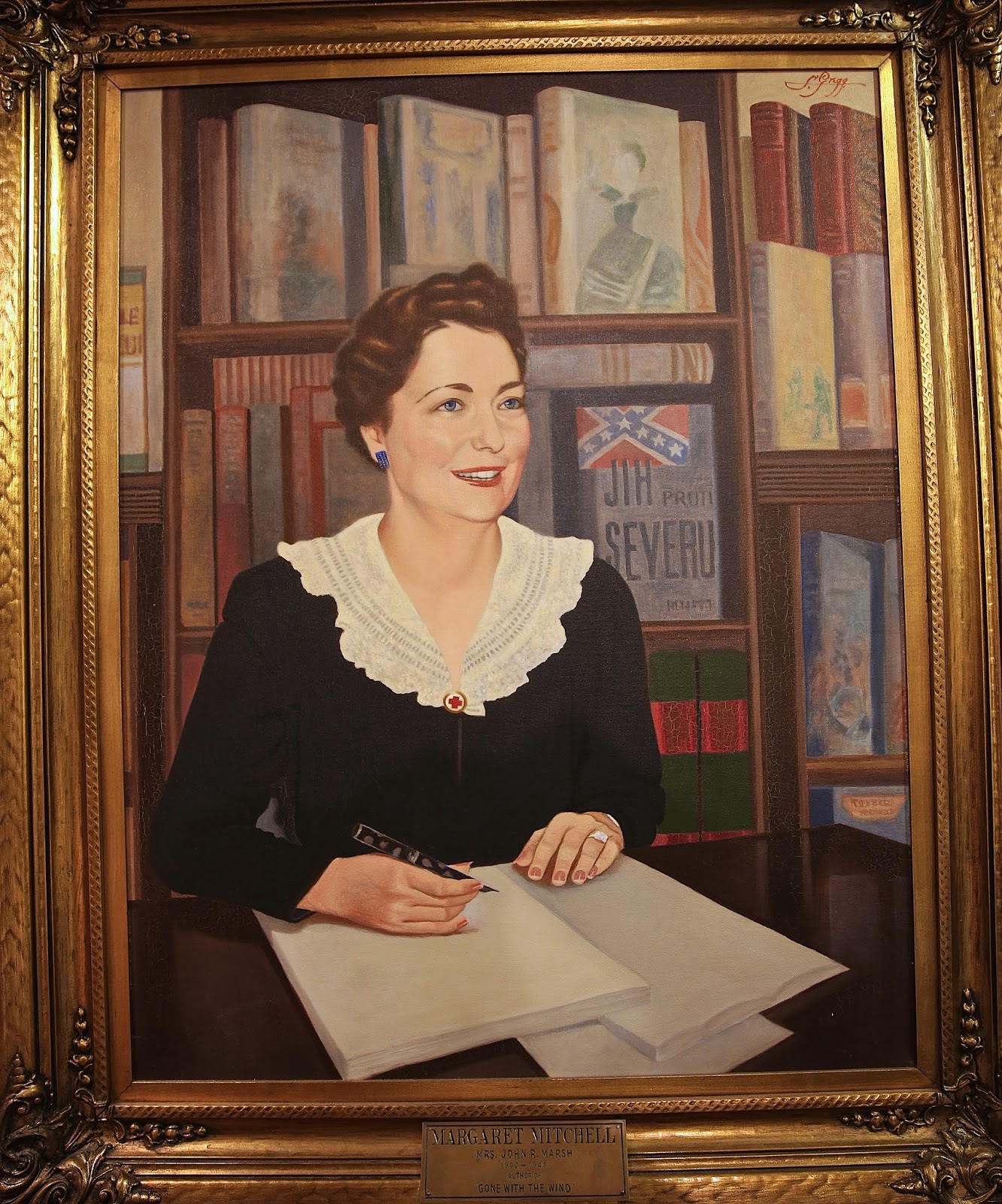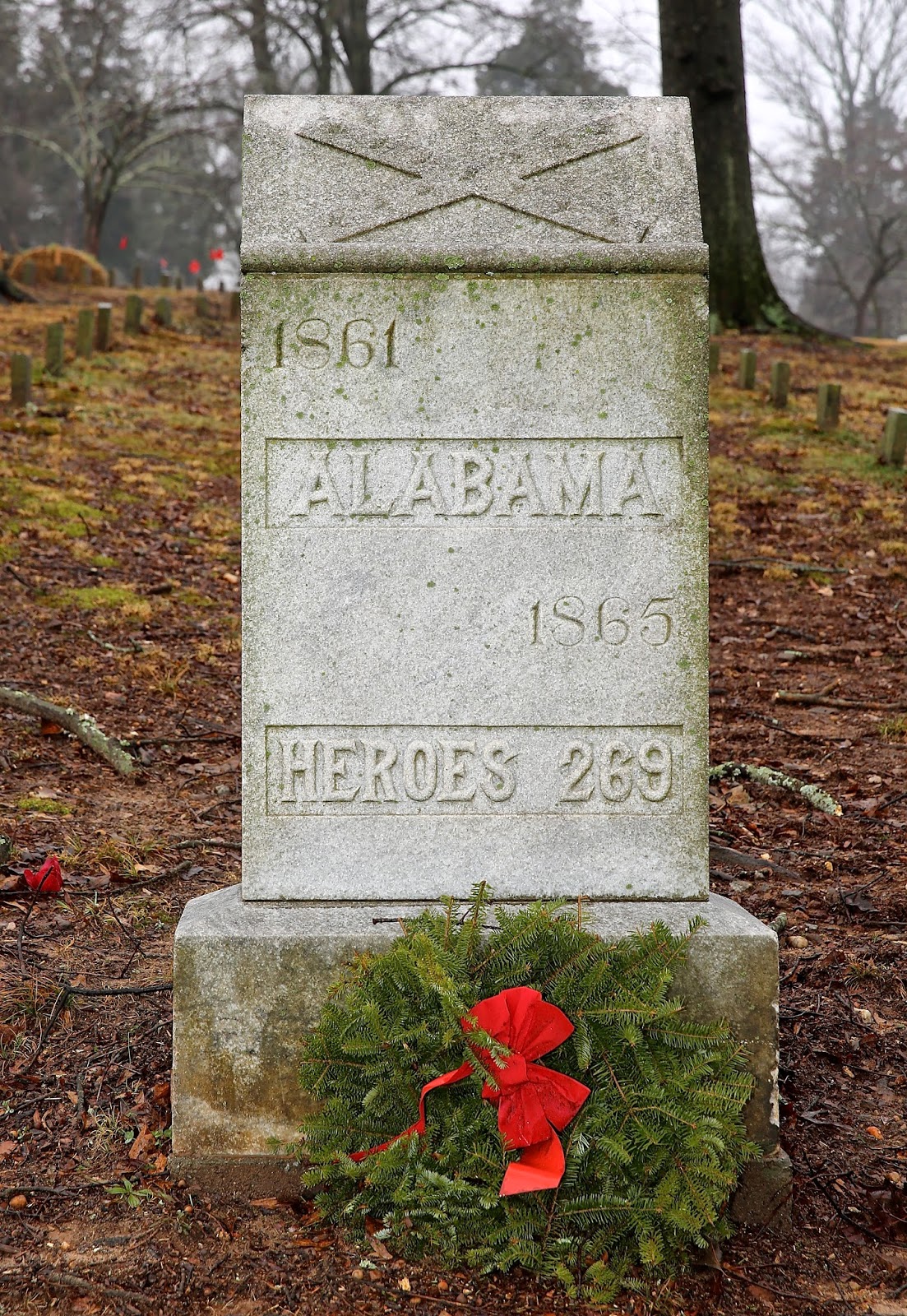On a recent cold, rain-filled and foggy weekend we were delighted to visit the big city of Atlanta, Georgia. We love to drive through this beautiful city and see all of the tall buildings and bright lights. I think of Atlanta as the Capital of the South.
As you can see in the below photo, it was so foggy during our visit we were unable to see the entire skyline of the big city buildings. The taller buildings were in the clouds. I loved the peaceful and silent beauty of this unusual weather pattern.
During this visit to Atlanta we had previously visited some Civil War historical sites and wanted to be sure to include the Margaret Mitchell House on our tour as well.
Atlanta Skyline
Margaret Mitchell House
990 Peachtree Street NE
Atlanta, Georgia
This lovely house is the restored home of "Gone With The Wind" author Margaret Mitchell. Surprisingly, the home is located right in the heart of downtown Atlanta. There was a convenient parking area located behind the house.
Even though the city has built up around the house it still retains it's charm and character.
The front porch rocking chairs send the message to "come and sit a spell."
The below photo shows the back of the house.
There was a slight mist of rain when we visited, and I did not realize at the time that the lens of my camera was getting a few misty raindrops as reflected in the above photo.
The tour of the home began at the back entrance. As you probably already know the entire home did not belong to Margaret Mitchell ... At the time she and her husband lived here, this was an apartment complex.
In the above photo, if you look at the bottom floor on the left, that is where her apartment was located.
Step into the hall and immediately on your left you will see the entrance to Margaret Mitchell's apartment. This is the room, and on the typewriter you see in the below photo on the left, that Margaret Mitchell began to write her book ...
In 1926 while working for the Atlanta Journal Sunday Magazine, Margaret suffered a sprained ankle in a car accident. As a result, she was bedridden and therefore wrote her magazine columns at home. Her injury was slow to heal and she eventually quit her job at the magazine.
While she was recovering, her husband brought books to her from the Atlanta library. Finally, when he claimed she had read all the books in the library, he brought home copy paper and suggested she write her own book.
Margaret's husband John also brought home a Remington Portable No. 3 typewriter. For the next three years Margaret worked on writing her Civil War-era novel.
Remington Portable No. 3 Typewriter used by Margaret Mitchell to write chapters of her book.
This might not be the same typewriter Margaret used, but one just like hers.
When Margaret was young she would often sit with family members including her grandmother and listen to Civil War stories they would tell. Her grandmother was a great source of "eye-witness information" about the Civil War and Reconstruction in Atlanta.
When Margaret was young her mother took her on a buggy tour through ruined plantations. Her mother talked about the world those people had lived in, such a secure world, and how it had exploded beneath them. An image of the South became fixed in her imagination.
In this photo you see Margaret Mitchell's work area in the Living Room.
With no outline, the subject and the location of the book were shaped in her mind from childhood stories and personal experiences. The story would begin with the Civil War and end with Reconstruction.
After three years of writing her book, she sat the finished book aside. Our docent in the Margaret Mitchell House said Margaret used a couple of chapters of her book to prop up a sofa leg for awhile.
Several years later in April 1935 a publisher from Macmillan Publishing Company came to Atlanta. He heard about Margaret's manuscript and asked if he could see it, but she twice denied it existed. She eventually did deliver the multiple paper-filled folders to him. After reading part of the book he immediately sent the folders to his publisher. In July a contract was signed. And the rest is history!
After three years of writing her book, she sat the finished book aside. Our docent in the Margaret Mitchell House said Margaret used a couple of chapters of her book to prop up a sofa leg for awhile.
Several years later in April 1935 a publisher from Macmillan Publishing Company came to Atlanta. He heard about Margaret's manuscript and asked if he could see it, but she twice denied it existed. She eventually did deliver the multiple paper-filled folders to him. After reading part of the book he immediately sent the folders to his publisher. In July a contract was signed. And the rest is history!
In this photo you see the opposite side of the Living Room.
Leaving the living room we went down the hall and into the tiny kitchen.
Hall
What a cute little kitchen.
Kitchen
A little dining table on the side wall of the kitchen.
Bedroom
Coming out into the hallway we see the stairway leading up to the second floor, going up to the "Gone With The Wind Museum."
Interesting stairway post carving.
Stairway to second floor.
Located just in front of the stairway, in the hall, we see ten mailboxes. They must represent how many apartments were located in the original building.
Mailboxes in the hallway.
There is a "Gone With The Wind" gift shop. Of course the book and the movie were available for purchase. We did purchase the Blu-Ray 'Gone With The Wind' DVD. We did see the movie many years ago, but we are looking forward to seeing it again.
Painting of Margaret Mitchell in the upstairs Museum.
She is the author of the masterpiece "Gone With The Wind."
Our guide took us through the upstairs Margaret Mitchell Museum and gave detailed information about the early and later life of this amazing author.
Margaret Mitchell was a Southerner and a lifelong resident of Atlanta, Georgia. She was born in 1900 into a wealthy and politically prominent family. Her father was an extremely successful attorney in the Atlanta area.
Early on Margaret received encouragement from her English teacher, who recognized her writing talent.
Margaret attended Finishing School in Atlanta, Smith College in Massachusetts and was an Atlanta Debutante.
Margaret attended Finishing School in Atlanta, Smith College in Massachusetts and was an Atlanta Debutante.
Margaret Mitchell as a teenager.
Margaret began a career in journalism writing feature articles for The Atlanta Journal Sunday Magazine.
Our guide told us many of Margaret's life experiences influenced the writing of her book Gone With The Wind ....
The below photo was on display in the Museum. This is a photo of Margaret interviewing a group of young men for her journalism job. This photo reminded me of the part in the book when Scarlett was surrounded by all the boys at the Bar-B-Que ...
An interesting quote from Margaret on display in the Museum.
I think she got her wish!
One million people came to Atlanta for the film's premiere at the Lowe's Grand Theatre in December 1939. The day was declared a state holiday by the Governor of Georgia. There were three days of festivities with a parade, a costume ball, and receptions. An estimated three hundred thousand people lined the streets for seven miles in hopes of getting a glimpse of the actors as they arrived from the airport
Photo of Gone With The Wind film premiere at the Loew's Grand Hotel in Atlanta.
If you would like to see a You Tube video of the premiere of Gone With The Wind you can click on the link below:
https://video.search.yahoo.com/video/play;_ylt=A2KIo9iZOsxUJG8ALB37w8QF;_ylu=X3oDMTBzc2M2MjdyBHNlYwNzcgRzbGsDdmlkBHZ0aWQDBGdwb3MDMTE-?p=youtube+premiere+of+gone+with+the+wind&vid=eb9cd3e0531025371271be652c697df8&l=4%3A02&turl=http%3A%2F%2Fts4.mm.bing.net%2Fth%3Fid%3DVN.608049026030700887%26pid%3D15.1&rurl=https%3A%2F%2Fwww.youtube.com%2Fwatch%3Fv%3DH0IkxV6b_V8&tit=Gone+with+the+Wind+-+Atlanta+Premiere+1939&c=6&sigr=11bs6v3f3&sigt=11a4u2fu6&sigi=11rsl89lt&age=1389803403&fr2=p%3As%2Cv%3Av&hsimp=yhs-001&hspart=mozilla&tt=b
Another picture in the Museum showed the main characters in the Gone With The Wind movie.
In the below photo we see another photo in the Museum showing Clark Gable who played Rhett Butler, one of the main characters in the movie. As you can see he is meeting with Margaret Mitchell. The story goes that they met for an hour before the showing of the movie and both were totally charmed.
Below we see another photo seen in the Museum.
It seems to me that so many artists, authors and gifted people never understand how good they are. I was struck by Margaret's quote at the beginning of the below photo:
"In a weak moment, I have written a book".... November 1935
Margaret Mitchell's amazing book Gone With The Wind won the National Book Award for Most Distinguished Novel in 1936, and the Pulitzer Prize for Fiction in 1937.
According to our Museum docent, while crossing Peachtree Street, not far from this house, in 1949 Margaret was hit by a taxicab driver and died 5 days later from her injuries. How sad!
Years later it was discovered that Margaret quietly had a significant number of charitable causes. Among many contributions to other organizations, she made arrangements for regular scholarship contributions to Dr. Otis Smith who became the first black licensed pediatrician in the state of Georgia. Her contributions also led to the establishment of an emergency room for African Americans at Grady Memorial Hospital in Atlanta.
Margaret Mitchell's Pulitzer Prize winner Gone With The Wind has been translated into 27 languages and has sold over 20 million copies.




















































